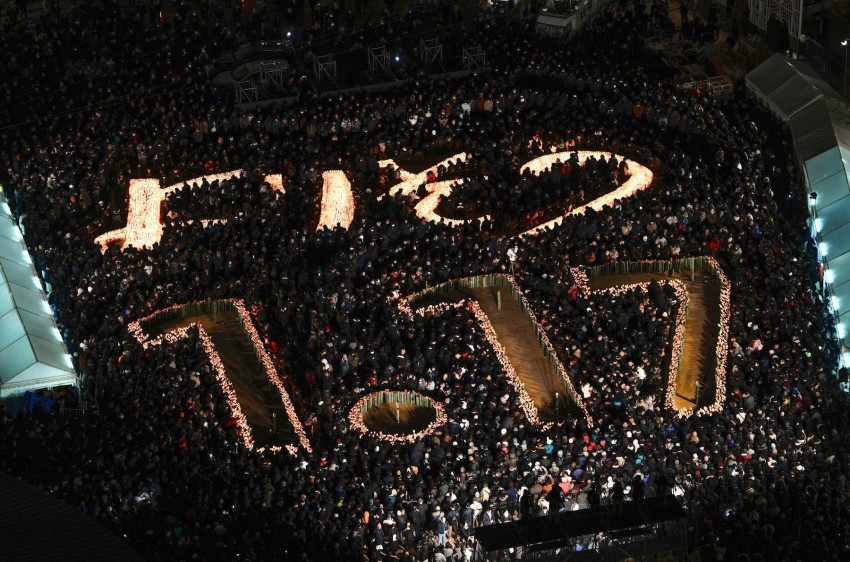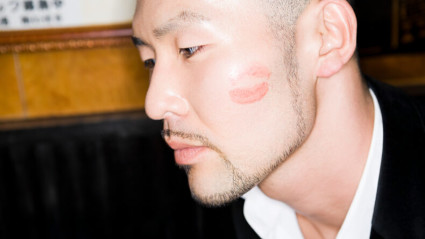The western Japan city of Kobe and nearby areas on Friday marked the 30th anniversary of the magnitude 7.3 earthquake that killed over 6,400 people, with many hoping to keep alive the memories as the devastating event continues to teach the importance of enhancing preparedness in the disaster-prone nation.
Residents and victims' families observed a moment of silence at 5:46 a.m., the exact time the Great Hanshin Earthquake struck Kobe and its vicinity in Hyogo Prefecture on Jan 17, 1995, leaving 6,434 people dead as many homes were flattened.
Thousands of paper and bamboo lanterns were placed at Kobe East Park to form the date "1.17," along with the Japanese word "yorisou," which means being together, in memory of other disaster-affected people such as those affected by the quake that hit Ishikawa Prefecture in central Japan on New Year's Day last year.
"We will continue on our way to the new era, keeping in mind the memory and remembering grief," Kobe Mayor Kizo Hisamoto said at a ceremony organized by the city.
Genki Hasegawa, a 38-year-old teacher who lost his mother and brother, spoke as a representative of the victims, saying, "We will pass on the lessons learned from the quake to make more people stand at the starting line for disaster prevention and mitigation."
A separate ceremony is planned by Hyogo Prefecture, with Emperor Naruhito and Empress Masako expected to attend.
The Kobe quake injured about 43,800 people and damaged or destroyed roughly 640,000 homes. As many as 310,000 people sought refuge in emergency shelters after the quake, and criticism of the government's initially slow response has spurred efforts to strengthen crisis management over the years.
People were shocked by TV images of the 1995 devastation, including a collapsed highway. Post-quake fires also destroyed 7,574 buildings.
Drawing on lessons from the quake, the government has implemented measures to improve disaster response, including establishing a crisis management center at the prime minister's office.
The quake prompted enactment of a law to provide post-disaster assistance to affected residents and spurred the widespread adoption of earthquake insurance.
In recent years, Japan has experienced a series of devastating earthquakes, including the January 2024 temblor that struck the Noto Peninsula. It is feared a megaquake could occur within the next 30 years along the Nankai Trough -- an ocean-floor trench along its Pacific coast where the Eurasian and Philippine Sea tectonic plates meet.
Prime Minister Shigeru Ishiba has pledged to establish a new disaster management agency to enhance and expedite responses to earthquakes, typhoons and other natural disasters. The agency is expected to be launched by fiscal 2026.
Passing on the lessons learned from the Great Hanshin Earthquake to younger generations has become increasingly challenging over the years.
A Kyodo News survey of 52 organizations in Hyogo that host memorial events for the quake highlighted the challenge. About 80 percent said it would be difficult to continue holding such events, primarily due to the decline in the number of those experienced the disaster firsthand.
© KYODO















18 Comments
Login to comment
P_C
Recall this event my very first time coming to Japan. Terrible tragedy. Unfortunately, the post-quake fires led to much of the destruction and death. Fire trucks couldn't access many of the neighborhoods full of wooden structures. Area is drastically improved!
deanzaZZR
I was teaching a class of tax officials from around Japan in Tokyo. Several were from the Kansai Area. Not too long after the quake hit the class was interrupted and staff came in to excuse the students from the Kansai area to share the news.
RIP victims of the 1995 Great Hanshin Earthquake.
That was a very sad day and period for all of Japan. A year later I moved to the Kansai region and lived there for several years. I was and remain a big fan of Kansai.
kurisupisu
Many roads were impassable due to fallen buildings but also there were breaks in many pipes leading to fire hydrants-no water.
However, rivers around Kobe should have been utilized more as sources of water.
Even after the quake, the local onsen (I used) close to Nagata had a plentiful supply of water which was a boon to the residents.
Even now, in 2025, 30 years after the quake, there are still pieces of land which are obviously vacant in Nagata
wallace
I came to live in Japan in 1994. Not coming from an earthquake-prone country, the Kobe earthquake was a shock to see on TV. We were living in Nagano then, and local food companies were trucking relief food to Kobe.
We moved to Kobe after the reconstruction and stayed 16 years. Lovely city. There were many sites where homes once stood.
Attended the yearly memorials for the victims.
Yubaru
30 years and just how many disasters later, and it still doesnt exist. Perfect example of Japanese bureaucracy!
It's sad, and everyone involved in the process should be ashamed.
JeffLee
The socialist prime minister at the time refused to dispatch the SDF, as he said that residents would be upset at the sight of people in military uniforms on their streets. Crazy times, indeed.
kurisupisu
Water was not available to many residents and the local municipal hospital on Port Island could be smelt before being seen.
The number of homes that just simply collapsed completely hid many bodies which fortunately, being January did not decompose quickly.
Had the disaster occurred in the summer then the situation would have been very different and the SDF would certainly have been needed.
wallace
The Kobe Yakuza were the first to hand out blankets, food, water, and toiletries to the victims.
At least 70 yakuza trucks were sent to the affected areas.
The yakuza delivered over $500,000 worth of relief goods.
wallace
Had a friend who was the CEO of a company in Osaka but the rail lines were destroyed. For several months he travelled from Kobe to Osaka and back by private boat.
browny1
I also experienced the quake from a neighbouring prefecture, at a much less intensity of course. I had arrived in Japan only hours earlier.
Originally I had planned to stay with a local couple who I met in Australia in Nada, Kobe.
But 1 month before I left, I got an offer to share a house with another student in another city.
My friends in Nada were safe but their house was completely destroyed. Always think how lucky I was.
As news filtered in in the morning, people were shocked esp with the news videos of destruction and fires.
Wallace - that may well be true about the Yakuza - embellished by folklore - but don't forget that the money/goods they spread were made off of the misery, pain and exploitation of 1,000s others - mainly ordinary folks. The yakuza were not godsends - they were merely propping up their base and influence, to consolidate themselves as rulers of the kingdom.
The largest group - The Yamaguchi clan - had headquarters in Nada and were the group you mentioned as supplying aid. They could do relief work because they were actually there and other help couldn't get in. But even tyrants historically gave aid to the peasants. Their list of bad-doings has no end.
And on a positive Kobe and Awaji have really bounced back. I recommend people to visit Awaji Island sometime. Many lovely spots.
kohakuebisu
A huge tragedy with many lessons to learn. The main one is that it was lucky for it to happen at 5:46 am and not when people were on the move. The Hanshin highway collapsed on the whatever multilane trunk road below is called (Route 47?), and the Shinkansen collapsed in four places. Hankyu Itami station, on the Japanese second floor, collapsed and crushed its first floor, luckily killing only a couple of policemen in the koban. Much of this was due to buildings and elevated structures not being built to withstand vertical movement. Kobe is on typhoon alley, so many buildings have heavy tiled roofs whose weight crushed the houses when they started shaking. The Chuetsu earthquake in Niigata had similarly aged houses, but built with fatter timbers for snow loads and few tiled roofs, so far fewer actual collapses.
The main lesson is that if you live in an old house, such as an akiya, you should reinforce it. A couple of months ago NHK's Science Zero said this typically costs 1.2 to 1.5 million yen, a small sum in the world of home renovations. Anyone with a new car, even a kei, will have spend at least that much more than I spent on my van. "Oh no we can't afford it" doesn't wash for many people.
wallace
I was not trying to justify the Yakuza and its criminal activities but in this case, they moved quicker than the government to give aid to the victims. Sometimes bad people can do good stuff.
grc
Engineers generally attribute the collapse of the Hanshin highway to inadequate structural design and to a lesser extent the materials used. Let us hope that all other structures designed and built in the 70s and 80s have now been retrofitted, and all subsequent ones built to the stricter standards brought in after the tragedy.
Cephus
Kobe forever strong!!
Peter Neil
i also remember it well. i’d been in japan for a few years already. the image of the toppled highway remains.
Yubaru
The truth is totally different. PM could not, by law, dispatch the SDF. Prior to the Hanshin quake, rules, regulations and precedents this along with political concerns about deploying the SDF for non-military purposes.
Laws were changed to allow the PM to dispatch them in cases of natural disasters, and they HAVE been since.
Be nice to have folks get their facts straight!
Yubaru
People's "google" skills seem to be lacking here!
browny1
Wallace - thanks.
Yes I didn't mean that you actually thought the Yakuza were saviors, but many people still do/did because of their aid at that time.
Probably need to clarify that when posting, because even some on this forum may well have thought,
"Well they can't be that bad".
In fact they are. As I said they were in a position to help because they were right there in the midst of the damage - it was their turf. I doubt any organized crime syndicates immediately moved into the zone from outside the prefecture, bearing benevolent offers of food, money and assistance.
Milked it for sure.